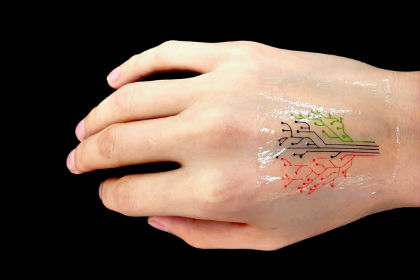|
NOVIDADES
Using a 3D printer, researchers have created a living tattoo that could be used for the next generation of wearable devices. Engineers from the Massachusetts Institute of Technology (MIT) have created a new ink from genetically programmed living cells that are engineered to light up in response to a variety of stimuli. The cells can be printed, layer by layer, to form 3D, interactive structures and devices when mixed with a slurry of hydrogen and nutrients.  MIT engineers have devised a 3-D printing technique that uses a new kind of ink made from genetically programmed living cells. Courtesy of the researchers.
The researchers were able to print a thin, transparent patch patterned with live bacteria cells in the shape of a tree, where each branch is lined with cells sensitive to a different chemical or molecular compound. The corresponding regions of the tree light up in response, when the patch is adhered to skin that has been exposed to the same compounds. The new technique could be used to fabricate active materials for wearable sensors and interactive displays, where materials can be patterned with live cells engineered to sense environmental chemicals and pollutants as well as changes in pH and temperature. The researchers also developed a model to predict the interactions between cells within a given 3D printed structure that can be used as a guide in designing responsive living materials. For several years, researchers have unsuccessfully attempted to use live mammalian cells to serve as responsive materials for 3D-printed inks. The cells are too weak and easily rupture. However, the team identified a hardier cell type in bacteria that has tough cell walls that are able to survive relatively harsh conditions. The bacteria is also compatible with most hydrogels—gel-like materials that are made from a mix of mostly water and a polymer. For the study, the researchers used a hydrogel with pluronic acid that exhibited an ideal consistency for 3D printing. “This hydrogel has ideal flow characteristics for printing through a nozzle,” Zhao said. “It’s like squeezing out toothpaste. You need [the ink] to flow out of a nozzle like toothpaste, and it can maintain its shape after it’s printed.” RandDMagazine. Posted: Dec 05, 2017. |
|||||||||||||||||||||||||